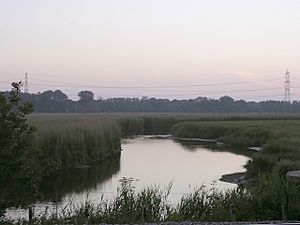Lower Test Valley facts for kids
| Site of Special Scientific Interest | |
 |
|
| Area of Search | Hampshire |
|---|---|
| Interest | Biological |
| Area | 142.0 hectares (351 acres) |
| Notification | 1986 |
| Location map | Magic Map |
The Lower Test Valley is a special place in Hampshire, near Totton. It covers about 142 hectares, which is like 350 football fields! This area is super important for nature. It's officially called a Site of Special Scientific Interest (SSSI) because of its amazing wildlife.
This valley is also part of bigger protected areas. These include the Solent and Southampton Water Ramsar site and Special Protection Area. It's also part of the Solent Maritime Special Area of Conservation. These names mean it's recognized internationally for its importance to nature. The Hampshire and Isle of Wight Wildlife Trust helps look after this beautiful nature reserve.
Contents
Why Lower Test Valley is Special
The Lower Test Valley is a fantastic home for many plants and animals. It has different types of habitats that make it unique. These include large areas of reeds, which are tall grass-like plants. There are also creeks that fill up with water when the tide comes in. You can also find natural grasslands and scattered willow trees.
Amazing Plants
More than 450 different kinds of flowering plants grow here. That's a lot of variety! One very rare plant found in the valley is the green-flowered helleborine. This plant is nationally rare, meaning it's hard to find anywhere else in the country. Protecting places like Lower Test Valley helps these special plants survive.
Wonderful Wildlife
The big reed beds in the valley are perfect for many wetland birds. These birds love to nest and feed in the reeds. You might see different types of ducks, geese, and other water birds. The valley's mix of habitats provides food and shelter for many creatures. It's a busy place for wildlife, especially birds.
What are Reed Beds?
Reed beds are areas where tall reeds grow very close together. They are often found near water, like rivers or lakes. These dense plants provide great hiding spots for birds and other small animals. They also help to filter water and keep the environment healthy.
Tidally Flooded Creeks
The creeks in the Lower Test Valley are special because they are "tidally flooded." This means that when the ocean tide comes in, these small waterways fill up with water. When the tide goes out, they might become muddy or have less water. This changing water level creates a unique environment. It's perfect for creatures that can live in both wet and muddy conditions.
Visiting the Reserve
It's important to know that you cannot access the reserve when the tide is high. This is because the water levels rise and cover the paths or areas you might want to explore. It's always a good idea to check tide times before planning a visit. This ensures your safety and helps protect the delicate environment.

